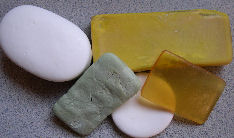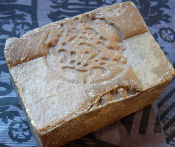Soap consists of the water-dispersible portion of a fatty acid (grease). Historically it was made from animal fat (or occasionally vegetable oil) mixed with lye derived from the ash of wood or other plants, although certain plant resins can be substituted in some cases. Basically you start with the fat and keep adding ashes as the water evaporates out of the fat, and in 4 to 11 days the fat gradually undergoes a chemical change called "saponification," a neo-Latin word that unhelpfully simply means "turning into soap." Better soap is produced by allowing a longer open-air drying time, often from four to six weeks.
The active chemical leached from the ashes is lye, called "caustic potash" when it is potassium hydroxide (KOH —the stuff used in alkaline batteries) or "caustic soda" when it is sodium hydroxide (NaOH —used in soap and also used in petroleum refining).

The next step is to remove impurities and glycerin (C3H8O3) before it is anything you would really want to use. (Nowadays various industrial processes agitate the soap with an alkali —and with other ingredients— to accomplish this.)
The process is time-consuming, but not particularly difficult. When I was a kid during World War II, soap and meat were both in short supply because of the war; when meat rations came our way, we saved the fat scraps and the neighbor lady made soap out of them. (It is partly to her that I owe an infancy spent mostly in clean diapers.)
Soap really became a commercially viable product only with the invention in 1790 of the "Leblanc process," which more efficiently uses soda ash from brine, allowing the mass production of soap in commercial quantities.
How Soap Works
Soap works because it dissolves in water, where it reduces surface tension of the water, increasing its ability to wet and loosen grime. Here are the steps:
- The surface being cleaned becomes wet.
- The soap gets absorbed.
- Grime is driven to the surface of the water and held in suspension.
- More water —rinse water— carries the soap-grime mixture off of the surface.
The History of Soap
Some medical or other chemical procedures of the ancient world worked through chemical actions that in effect produced soap. Sumerian texts suggest that one procedure used in the treatment of wounds was to heat fat or resin with lye or ash, typically an alkali procured from burning certain plants. We can assume that the result would have been a kind of soap, although not necessarily recognized as a general cleanser. Ancient Egyptians, partly contemporaries with the Sumerians, would probably have borrowed soap if it had been known, and did apparently borrow the idea of mixing fat boiled with alkali for use in treating wounds, but they did their general cleaning with naturally occurring sodas or with absorbent clay, so far as we know.
Soap was recognized as a cleaning agent in IInd century, and is reported by the Roman physician Galen (A.D. 130± - 200±) as helping to keep a person clean, although little was done with the knowledge. By the European Middle ages soap had come to be made at home for use with laundry, although the probability is that strong lye would have made it potentially irritating to the skin if used as hand soap, as is still true of lye-soap intended for laundry use.

Commercial cake soap ("toilette soap") such as that shown at the top of the page appeared only in the XIXth century and would have been unknown to, say, George Washington, although a similar product —"Soap of Damascus," shown in the picture at the right— was being made in Syria for a considerable period before that.
In the United States today liquid hand soap, which was developed in 1865 but which became popular starting in the 1980s, has become so widespread that bar soap now accounts for only about a third of the market for soap, bath, and shower products. Critics note that the plastic dispensers and the tendency to use far more soap than needed, make liquid soap less ecologically friendly than bar soap. Further, some of the antibacterial chemicals (notably triclosan and triclocarban) that once sustained the claim that liquid soap was more hygienic have been banned by the FDA because they have not been shown to be safe for long-term use.
(The fact that people reproduced themselves before the modern era brought soap to reduce the odor of the unwashed human body has been described as a "triumph of biology over aesthetics.")
Sources include:
- MAJNO, Guido
- 1975 The healing hand: man and wound in the ancient world. Cambridge MA: Harvard U. Press.
- "Mr. Green"
- 2017 Is liquid soap worse than bar soap? Sierra, July-August 2017: 12.
Photos by DKJ
